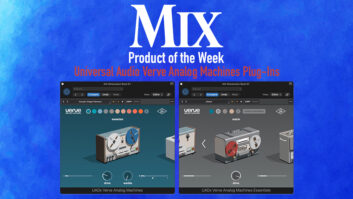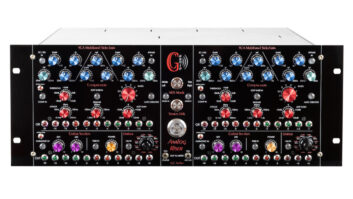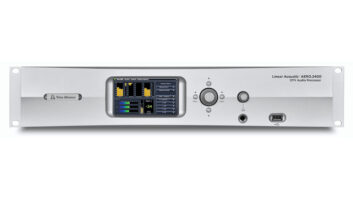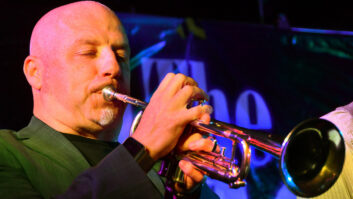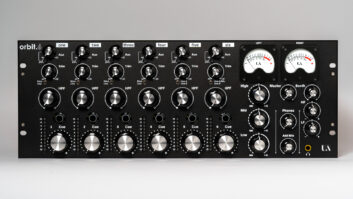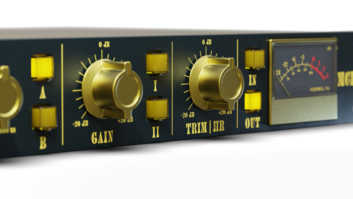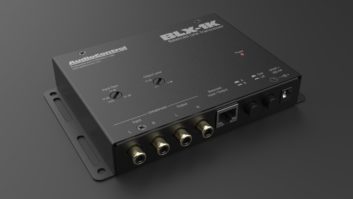To many engineers, brand names such as Teletronix, Fairchild, Neve and Pultec represent the pinnacle of audio quality. The most heralded equipment from recording’s past typically features all-tube or discrete, Class-A, solid-state audio paths with point-to-point handwiring. In other words, what endures over time endures for good reason.
Recognizing the fact that the demand for vintage signal processors exceeds the surviving supply, a number of manufacturers have developed reissue versions of particularly desirable designs, or have adapted aspects of those seminal designs to new creations that also incorporate some modern components. Today, it seems, we can have the best of both worlds: yesterday’s sound in a brand-new box.
We’ve spotlighted a selection of these “neo-retro” offerings, including analog compressor/limiters, EQs and mic preamps. All of these products are closely based on vintage gear designed before 1980; some models are straight reissues. And for the purist who prefers the originals, we’ve also listed companies that offer new rack housings for vintage modules (see “Restoring the Genuine Article,” page 108).
Whether you’re looking for an up-to-date repackaging of classic electronics or a “new retro” device, the goal of combining vintage sounds with modern reliability is no longer an elusive dream. The following presents three dozen such products, listed alphabetically by manufacturer, and for more information, a section of phone and Web contacts is provided.
ANTHONY DEMARIA LABS ADL 1000 AND ADL 1500
The ADL 1000 Mono Tube Compressor ($1,695 list) is closely based on the famed Teletronix LA-2A optical leveling amplifier and employs that unit’s original T4 electro-optical cell and Allen-Bradley pots. The 1000’s all-tube audio path features input and output transformers that are produced in-house. And while the off-the-shelf 12AX7A tubes, power transformer, power supply, caps and resistors differ from the respective components used in the original LA-2A, all are interchangeable with the vintage leveler’s parts. The archetypal two-knob design (employing peak reduction and gain controls) facilitates fast and easy setup. XLR I/O, VU metering and stereo-linking capabilities are standard.
The ADL 1500 Stereo Tube Compressor ($2,995 list) is a dual-channel version of the ADL 1000, featuring virtually the same circuit design. Independent controls and VU meters serve the two independent channels.
API 212L, 512C, 525, 550B, 7600
Part of API’s L200-powered rack system, the API 212L Mic Preamp Module ($625) uses the same circuit design as the legendary API 512b preamp and the preamps in the company’s Legacy Series Console. The modular unit’s all-discrete, solid-state circuitry utilizes API’s proprietary 2520 op amp, an RE-115K input transformer and an AP-2623 output transformer. The clip point is a hefty +28 dBm. Features include switchable 48-volt phantom power and -20dB pad, a 5-segment LED meter with VU ballistics and a continuously variable gain control that offers up to 55 dB of gain.
The API 512c Mic/Line Preamp/DI ($825) is a single-channel module based on the original, 1967-vintage API 512. Designed around the API 2520 op amp, the 512c fits into 2, 4 and 10-slot API-powered racks, as well as API Legacy and Classic Consoles. For convenience, rear panel XLR mic and ¼-inch, hi-Z, unbalanced line inputs are duplicated on the front panel. There are front panel switches for polarity inversion, 48V phantom power, -20dB mic/line input pad and mic/line input switching. Metering is via a 7-segment LED (with VU ballistics). The continuously variable gain control dishes out 10 to 65 dB of gain for mic signals, and 14 to 50 dB for line/DI signals. The 512c will take up to +30 dBu before barking.
The API 525 Feedback Compressor/Limiter ($1,295) is a reissue of the company’s original 525 solid-state comp/limiter from the early ’70s. Designed to fit 2, 4 or 10-slot API-powered racks, the fully discrete 525 packs a lot of controls onto its economical faceplate: input and output level control knobs, ratio switches (2:1 or 20:1), Auto Release mode switches (offering 0.1, 0.5, 1.5 and 2.0 seconds release time), a switchable de-essing filter for the sidechain, VU-type gain reduction meter and hardwire bypass switch. Additionally, a “ceiling” fine-tune knob simultaneously varies the threshold and makeup gain to keep output levels constant. The 525’s attack time is fixed at a warp-speed 15 microseconds, and up to 25 dB of gain reduction is possible. API’s proprietary 2510 and 2520 op amps give the 525 its distinctive sound.
The API 550b 4-Band Switchable Equalizer ($1,295) is a reissue of the 1967-era 550 EQ, but with the addition of an extra frequency band and several new frequencies. Each band offers peaking filters with ±12 dB of boost/cut and a choice of seven center frequencies spanning four or five octaves. There is considerable overlap between frequency bands, and bands 1 and 4 can be switched to shelving-type response. API’s “Proportional Q” circuit design automatically narrows the filter’s Q as boost/cut is increased. The 550b uses the API 2520 op amp and can take levels up to +30 dBu before clipping. The module is built to live in 2, 4 or 10-slot API-powered racks.
The API 7600 Input Module ($2,995) is a rackmountable, 4-bus channel strip. It’s loaded with a mic pre, equalizer, compressor, sends, buses and solo. The mic pre is the 212L from the 200 Series Legacy Console. The EQ is basically a reissue of the vintage 550A 3-band EQ, except that it offers seven center frequencies per band. The compressor is the 225L, found in current all-discrete API Legacy Consoles. Other features include panning, mute group, insert and metering facilities, the latter consisting of three 7-segment LED displays with VU ballistics. The API 2520 op amp does the heavy lifting in this internally powered jack-of-all-trades. All I/Os are on the rear panel. Several 7600s can be linked together and interfaced with the API 7800 Master Module ($2,495), which provides the functionality of a mixer’s master section, to create a custom console.
EAR 660, 822Q, 823MQ
Esoteric Audio Research’s 660 Fairchild-type (hybrid) tube limiter/compressor ($4,250) is designed to operate with the minimum of interference below threshold. Attack/release times are similar to other comp/limiters, but its characteristics around the “knee” of the attack/decay envelope contribute to its excellent performance. EAR’s 822Q Pultec-type program equalizer ($3,290) has passive filters designed for minimal phase shift/ringing followed by a balanced tube output amplifier stage. Variations include lowpass, highpass, bandpass filters and HF/LF shelf, with variable Q and turnover frequency. The EAR 823MQ mid-EQ ($3,290) is a mid band variant on the 822Q, with fewer but more closely spaced facilities over a narrower frequency span for greater precision in this critical band.
FAIRMAN TMC AND TMEQ
Based on the classic Fairchild 660 (mono) and 670 (stereo) tube compressors, the Fairman Tube Master Compressor, or TMC ($8,000 U.S. list), sports independent makeup gain controls that are adjustable in 0.5dB increments. The unit’s threshold controls are switched in 0.125 to 0.5dB increments throughout its range. Combination attack/release controls are also provided for each channel. The rackmountable, 6U, 55-pound behemoth can be linked for stereo operation. Large VU meters show audio levels or gain reduction. Sixteen tubes glow inside the unit: two quartets of matched ECC81s and ECC82s per channel. Input and output transformers are handwound over mu-metal cores. Other features include a Class-A VCA; 20-position, gold-plated switches; and an externally located main transformer (to preclude hum).
The Fairman Tube Master Equalizer, or TMEQ ($8,000 U.S. list), uses the same frequency-controlled tube amplifier design as was used in the Klein+Hummel Universal Equalizer UE-100 in the late ’60s. In order to maintain precise control when treating stereo program material, this 2-channel, 6-band, all-tube equalizer features only switch controllers for adjusting center frequency, boost/cut and Q settings. Each channel sports two parametric mid bands, separate low-cut and low-boost bands, and separate high-cut and high-boost bands, with considerable overlap between bands. The 6U, rackmountable unit is completely handbuilt and houses no less than 22 tubes! Other features include independent hardwired bypasses for all 12 amplifier circuits, a master hardwire bypass, and input/output gain switches that provide ±6dB boost/cut in 0.75dB increments.
MANLEY STEREO VARIABLE-MU LIMITER COMPRESSOR, ENHANCED PULTEC EQP1A, MID-FREQUENCY EQUALIZER AND MIC/EQ 500 AND LANGEVIN EQP1-A
Based on the old Danish DISA limiter, the Manley Stereo Variable-Mu Limiter Compressor ($4,000) uses 5670 variable-mu, dual-triode tubes as the gain control elements for its two channels. A ganged input level control is shared by both channels, suggesting mixing and mastering applications as the unit’s raison d’être. However, the channels can be linked or operated independently, and you can make different adjustments to the independent threshold, attack, recovery (release) and make-up gain controls on each channel for dual-mono applications. Independent Limit/Compress switches further facilitate this flexibility. In Compress mode, the Variable-Mu delivers a mild 1.5:1 ratio. Limit mode gradually increases the ratio from 4:1 to 20:1 as increasing input gain is applied to the 5670 tubes. Large, illuminated Sifam VU meters, balanced I/O and independent bypass switches further grace each channel of this all-tube-path squeeze machine.
Manley Laboratories is the only authorized manufacturer of the original Western Electric passive EQ circuitry that was used in the highly sought-after vintage Pultec. The Manley Enhanced Pultec EQP1A ($2,150) and Mid-Frequency Equalizer (MEQ-5-type; $1,750) are updated versions of these seminal tonmeisters, offering additional frequencies to those found in the original Pultecs. Manley also used its own tube stage and power supply designs, plus modern componentry with higher tolerances throughout the signal path, to bring the two 1U, rackmountable EQs into the 21st century (a 2U, stereo version of the EQP1-A is also available for $3,300). Both units can be set to flat response or bypassed entirely. The EQP1A uses one 12AU7WA and one 6414 tube in its all-tube makeup gain stage. Manley also offers the Langevin EQP1A ($1,275), which is essentially identical to the Manley unit having the same model number, except that the Langevin employs an all-discrete, solid-state makeup gain stage.
The EQP1A and Mid-Frequency equalizers both provide transformer-balanced and transformerless, unbalanced rear panel I/Os, while all I/Os for the Langevin EQP1A are transformerless. The Manley Mid-Frequency Equalizer offers sharper dip/peak curves than the Manley EQP1A and also fills in some of the frequency gaps of the latter unit.
The Manley Mic/EQ 500 Combo ($2,900) is, as the name suggests, a combination mic preamp and equalizer. Both processing sections can be used independently of one another. The unit’s passive EQ section is closely based on the Art Davis EQ 500 design from the ’60s, but differs in that it offers a choice of Peak or Shelf modes for each band. Manley also used its own differential tube stages and power supply for the unit. Davis’ 2dB stepped switching design never puts more than three components in the audio path, maintaining signal purity. The fully differential, all-tube, single-channel Mic/EQ 500 offers a VU meter, insert point, high-current 48V phantom power, mic input phase reverse and up to 55 dB of total gain from input to output. As with all of the above-mentioned Manley and Langevin models, a special mastering version is available.
MERCURY 66, EQ-H, EQ-P, M72 AND M76
All of Mercury Recording Equipment’s products feature all-tube audio paths, transformer-balanced I/O and point-to-point handwiring. Chassis and front panels sport a distinctive 1950s look, with engraved lettering and either powder coating or baked-enamel finishes.
Due out this fall, the Mercury 66 Limiting Amplifier ($5,999 list) is based on the famed Fairchild 660 Variable-Mu compressor. The Mercury 66 offers 2:1 compression and 20:1 limiting, as well as all ratios in between (transitioning gradually to the higher ratios as input levels increasingly exceed the threshold). The 66 dishes out a lickety-split 50-microsecond attack time. The release time varies from 0.3 ms to 25 seconds, with three of the unit’s six presets functioning in a program-dependent manner. The 4U rackmountable unit also offers input, threshold and metering controls. Glowing inside are 6BC8, (2) 6V6, 12BH7, 12AX7, EL34, GZ 34 and 5751 tubes.
Due to ship sometime this summer, the Mercury EQ-H Program Equalizer ($2,399 list) is based on the Pultec equalizers of yesteryear. Continuously variable controls afford ±16dB boost/cut on high frequencies and 13.5 dB of boost and 17 dB of cut on lows. The transformer-balanced I/O and single-ended makeup gain amplifier remain true to the original Pultec. At your command are five low-shelf boost and cut frequencies, nine mid- and high-boost frequencies and a high-shelf cut at 10 kHz. 12AX7 and 12BH7 tubes warm things up.
Also due to ship sometime this summer is the Mercury EQ-P Program Equalizer ($2,899 list), another Pultec-type spin-off. It departs most noticeably from the EQ-H in its offering of three high-shelving cut frequencies at 5, 10 and 20 kHz, and slightly greater amount of boost in the mid- and high-peaking filters. Also, the tubes that are used are 12AX7 and 12AU7. Continuously variable gain controls, transformer-balanced I/O and a fully balanced (push-pull) makeup gain amplifier remain true to the original Pultec EQ. The only modern twist here is a rear panel switch that allows you to remove an interstage transformer for a different sound.
Due to ship this winter, the Mercury M72 Studio Microphone Amplifier ($TBA) is a dual-channel offering in the tradition of the classic Telefunken Studioverstarker V72, which was used by The Beatles in their early recordings at Abbey Road Studios. Features will include 34 to 56 dB of gain, phase reverse, -15dB input pad, switchable phantom power and a transformer-balanced DI input. Two EF 86 tubes will light up your world.
Also watch for the Mercury M76 Studio Microphone Amplifier ($TBA) sometime this winter. Based on the Telefunken Studio-Mikrofonversarker V76 of the late ’50s and ’60s, the dual-channel M76 will add a line input, impedance selector and output fader to the classic design. Other features will include phase reverse, -15dB pad, switchable phantom power and a transformer-balanced DI input. Two EF 86 tubes are used here, as well.
NEVE 1081 AND 33609/J
The Neve 1081 Channel Amplifier was first produced in 1972 for use in Neve consoles such as the 8048. The combination mic preamp and equalizer is available as a stand-alone module or in either of two multirack forms: The 3U rackmountable AM3631 gives you two units mounted horizontally, or the 7U rackmountable AM3630 provides eight units mounted vertically. Both multirack forms provide transformer-balanced mic/line I/O on XLRs, unbalanced outs on a “D” connector, phantom power and main power supply. The mic pre offers +10 to +80dB gain in 5dB steps; -15 to +20 dB of gain is available for line inputs. The EQ section consists of five switched high and five switched low frequencies (bell or shelf response), plus 10 switched high and 10 switched low-peaking frequencies with switchable high and low Q. All of these filters offer ±18dB continuously variable boost/cut. High- and lowpass filters (HPF, LPF) feature five switched center frequencies for each. Phase invert and EQ bypass switches are also included.
The Neve 33609/J Precision Stereo Limiter/Compressor is based on the circuit design first used in the classic Neve 2254 limiter/compressor, circa 1969. The 2-channel, 2U rackmountable processor is geared toward both music recording and broadcast applications. Independent sidechains and threshold, attack and recovery controls are provided for both the limiter and compressor sections on each channel. Compression ratios are switch-selectable from 1.5:1 to 6:1 in five steps, and gain reduction is shown on independent moving coil meters for each channel. The compressor’s 0 to +20dB makeup gain (in 2dB steps) is situated before the limiter section. The “J” in the model name denotes the addition of illuminated master switches (Bypass, Mono/Stereo, Int/Ext) and provision for remote control. Multiple units can be linked for multichannel operation.
PURPLE AUDIO MC76
The Purple Audio MC76 ($2,000) is a monaural FET peak-limiting amplifier based on the UREI 1176. Attack times range from a blistering 20 microseconds to 800 microseconds, enabling unique sound-sculpting capabilities that are difficult to obtain from most non-FET devices. Release times range from 50 ms to 1.1 second. As with the 1176, ratios are 4:1, 8:1, 12:1 and 20:1. The all-discrete, solid-state MC76 features transformer-balanced I/O on XLRs; a VU meter for showing output gain and gain reduction levels; a single-element, Class-A output amplifier; toroidal power transformer; heavy-gauge, stainless steel case; and numerous other “hardening” improvements.
SHEP SN8, SN12, SNC6 AND SNDC6
UK manufacturer Shep and Associates has enlisted the help of Mr. Rupert Neve to produce several processors based on classic Neve designs.
The Shep SN8 Classic EQ Module ($2,700) features the same basic circuit design and chassis as the classic Neve 1073 mic preamp/equalizer and uses the original transformers, wire, switches and Class-A circuit architecture. However, Shep has updated the unit with a fourth band of EQ and additional passive frequency selections, making the SN8 more like a Class-A version of the Neve 1081. The head amp’s sensitivity can be switched to accept either mic or line inputs via the multipin, transformer-balanced Amphenol connector on the rear panel. EQ facilities include three bands of peaking filters, each with a generous allotment of switched center frequencies (the high-frequency band can also be switched to produce a shelving curve); a low-frequency shelving band; and an additional HPF with a choice of three corner frequencies. The SN8 is fully compatible with Neve consoles and can drop into existing 1073-sized (8-inch) console slots to fill out missing modules.
The Shep SN12 Classic EQ Module ($3,425) is equivalent to the Neve 31105 (as used in the 8078 Series Neve consoles) and features the same Class AB circuit design, transformers and switches, but has been updated with a Class-A output stage similar to that used in the Neve 1073. The head amp’s sensitivity can be switched to accept mic or line inputs. The EQ facilities go way beyond those offered in the SN8, adding switchable high Q settings for the low-mid and high-mid bands, switchable peak/shelving curves for the lows, an additional lowpass filter with five switched frequencies and more choices of corner frequencies for the highpass filter. The 12-inch-high module can be used to fill out same-sized slots on existing Neve consoles, interfaced via an Amphenol connector.
The Shep SNC6 Compressor Limiter Module ($2,750) is based on the Neve 32264a compressor used in the Neve 8058, 8068 and 8078 consoles. Features include limiter threshold and recovery controls; compressor threshold, recovery, ratio and makeup gain controls; gain reduction meter; stereo link toggle; and independent bypasses for limiter and compressor sections and for the entire unit. Two Auto Attack/Release modes complement four fixed recovery settings for both the compressor and the limiter. The Shep SNDC6 ($4,370) is basically two SNC6 modules in a 2U, rackmountable chassis, and comes complete with internal power supply and switchable stereo linking.
TRIDENT-MTA A-SERIES DUAL-DISCRETE CHANNEL MODULE
Trident-MTA has reissued the original channel module from the 1973 vintage Trident A Series console with minimal modifications. The Trident-MTA A-Series Dual-Discrete Channel Module ($3,699.99 list) is a stand-alone, rackmountable, dual-channel unit that features a transformer-coupled mic preamp; highpass and lowpass filters (each offering a choice of three fixed frequencies); a 4-band, inductive EQ section with a choice of four fixed frequencies per band; and a new output gain control for each channel. The mic pre provides stepped input gain control, phase reverse and phantom power. LPFs and HPFs remain true to the original unit’s all-discrete, Class-A, second-order filters. Controlling the series and parallel inductive tuned circuits are 70mm linear faders in the discrete, Class-A EQ sections, and provide up to 15dB boost/cut. The new, wide-ranging output gain stage varies from +28 dB to Off. The EQ can be bypassed.
TRIDENT AUDIO DEVELOPMENTS S80
Based on John Oram’s electronic design for the 1975 Trident Series 80 console is the S80 Producer Box from Trident Audio Developments. Housed in a wooden box made of English ash, the S80 is essentially two input channels, but with the addition of a 48 VDC phantom power switch and balanced insert points. Features include mic and line inputs, 4-band EQ with sweep mids and high/low shelving, XLR direct channel outs, and a L/R mix bus output with pan, mute and 100mm faders. Retail: $3,499.
UNIVERSAL AUDIO TELETRONIX LA-2A, 1176LN AND 2-610
The Universal Audio Teletronix LA-2A Leveling Amplifier ($3,495) is an authentic reissue of the legendary, all-tube compressor from the ’60s. Virtually all-original parts were used in the reissue, including the T4 electro-optical cell, HA-100X input transformer, UTC A-24 output transformer and identical tube complement. The single-channel, 3U, rackmountable LA-2A features peak reduction and makeup gain control knobs, XLR and barrier strip I/O, and a Compress/Limit switch. Compression mode delivers a soft-knee curve with a 4:1 ratio. In Limit mode, the unit provides an infinity:1 ratio. A large, illuminated VU meter can be switched to show either gain reduction or output level, with the latter referenced to either +4 dBm or +10 dBm. The LA-2A provides up to 40 dB of gain reduction.
The Universal Audio 1176LN Limiting Amplifier ($2,295) is a faithful reissue of the late ’60s-era, blackface (D and E revisions), solid-state dynamics processor. The 1176LN’s FET gain control element delivers lightning-fast attack times as short as 20 microseconds (and as long as 800 microseconds), allowing creative sound sculpting on drums (and other sources) that’s just not possible with most non-FET-based compressors. Release times range from 50 ms to 1.1 seconds. Ratio values (4:1, 8:1, 12:1 and 20:1) are switched by push buttons on the front panel; pushing two or more buttons simultaneously creates a unique, urgent sound. Front panel features include continuously variable input, output, attack and release control knobs. An illuminated VU meter can be switched to show either output or gain reduction level. Rear panel connections are via XLRs and barrier terminals.
The Universal Audio 2-610 Microphone Preamplifier ($2,295) incorporates the mic preamp section from the 1950s-era 610 tube recording console, which was used to record Frank Sinatra, Sarah Vaughan, the Beach Boys and others. The 2U, rackmountable 2-610 uses the same tube complement and componentry values as the vintage console, but a higher-quality power supply, polypropylene caps and metal film resistors bring the mic pre up to today’s standards. Newly added features for the dual-channel unit include switchable polarity inversion and phantom power; a transformerless, high-impedance input (for DI or line input); rear panel XLR I/O; and enhanced shelving EQ. Low-shelving center frequencies are 70, 100 and 200 Hz. High shelving can be switched in at 4.5, 7 or 10 kHz. Also, front panel controls vary the mic input impedance.
VINTECH AUDIO X73 AND 1272
The Vintech Audio X73 Microphone Preamp with Equalizer ($1,995) is based on the Neve 1073 module; the single-channel X73 includes the 1073’s Class-A amplifier design, inductors and transformers. Building on the 1073’s feature set, the X73 has been given a greater selection of switchable high-shelving EQ, with corner frequencies now at 10, 12, 14 and 16 kHz. The 1U rackmountable unit offers up to 80 dB of gain, three bands of EQ (bypassable and including an HPF), switchable phantom power, both DI and transformer-balanced line inputs, and an output level meter. The X73 requires an outboard power supply ($225), but the supply can power up to four modules.
Also from Vintech, the 1272 Microphone Preamplifier ($1,595) is a 2-channel, all-discrete, Class-A mic preamplifier closely based on the Neve 1272. The 2U, rackmountable Vintech 1272 is transformer-balanced and provides up to 50 dB of gain. Features include an input attenuator, output control, DI input, output level meter, and switches for polarity inversion and phantom power.
Michael Cooper is a Mix contributing editor and owner of Michael Cooper Recording in beautiful Sisters, Ore.
RESTORING THE GENUINE ARTICLE
A few manufacturers specialize in “rehousing” vintage signal processors in new rackmount hardware. In many instances, the modules are recapped and refurbished to meet original specifications. Here’s a quick look at who’s putting a new face on old favorites.
Boutique Audio & Design makes custom and standard rackmount housings for a variety of vintage audio devices, such as Neve (1272, 1066, 1073, 1081 and 1084) and Telefunken (V76 and V72) modules. All include rear panel XLRs and power supplies.
Brent Averill Enterprises offers classic Neve 1272 mic preamps; Neve 1064/A, 1066, 1089 and 1073 equalizer/preamps; the Neve 2254 compressor/limiter; the Calrec 1061/1161 equalizer/preamp module; and mic pre’s made from vintage API components. Most units are rackmountable and have their own power supply. The API pre’s require an API or Aphex LunchBox-powered rack.
Looking for a pair of Telefunken/Siemens V72s or V76s? Marquette Audio Labs offers these in rackhousings. Also available are Telefunken V672 module pairs; Neve 1073, 1084, 1081 and 33114/33115 preamp/EQ dual modules; the Neve 1272; Langevin AM16 pairs and “six packs”; Calrec 1061, 1161, PQ14 and PQ15 modules; and miscellaneous Siemens, Telefunken and Neumann discrete preamps and EQs from the ‘70s.
Vintage King Audio takes Neve 1066, 1073, 1089, 1081 and 1095 modules and gives them a brand-new home. Amenities include an internal power supply, rear panel XLR I/O, switchable 48V phantom power and DI input all in a custom, self-enclosed rack. Vintage King also offers the Audix 35102, the Calrec 1161, and Decca, Telefunken and Helios equalizer/pre’s.
MANUFACTURER’S CONTACT INFORMATION
Anthony DeMaria Labs 845/256-0032; www.adl-tube.com
API 410/381-7879; www.apiaudio.com
Boutique Audio & Design 818/340-6930; www.boutiqueaudio.com
Brent Averill Enterprises 818/784-2046; www.brentaverill.com
Esoteric Audio Research 323/667-1899; www.earpro.com
Fairman (45) 3 672-2723; www.fairman.dk
Manley Labs 909/627-4256; www.manleylabs.com
Marquette Audio Labs 510/581-3817; www.marquetteaudiolabs.com
Mercury Recording Equipment 510/581-3817; www.mercury-rec.com
Neve (44)128 245-7011; www.ams-neve.com
Purple Audio 718/482-8494; www.purpleaudio.com
Shep and Associates (44)176 326-1686; www.shep.co.uk
Trident Audio Developments 847/530-8161; www.tridentaudio.co.uk
Trident-MTA 310/373-9129; www.pmiaudio.com
Universal Audio 831/454-0630; www.uaudio.com
Vintage King Audio 313/965-0645; www.vintageking.com
Vintech Audio 813/643-8114; www.vintech-audio.com

